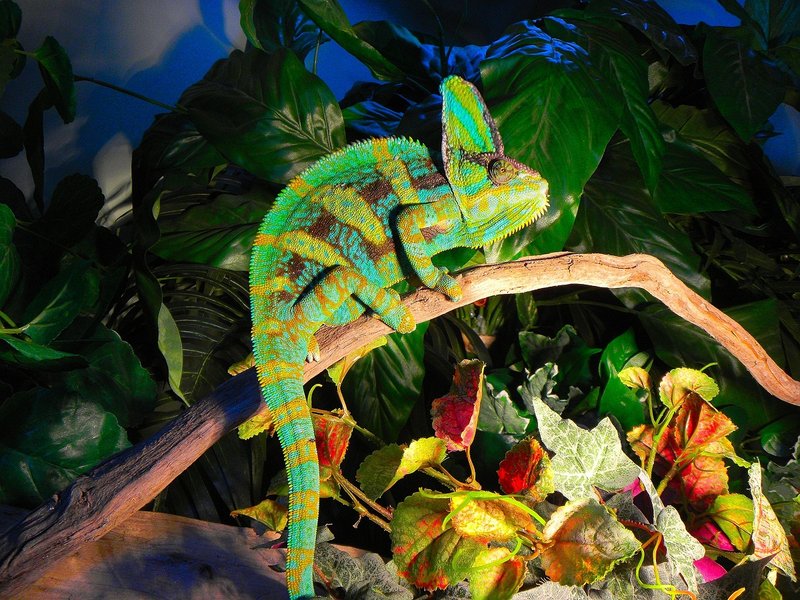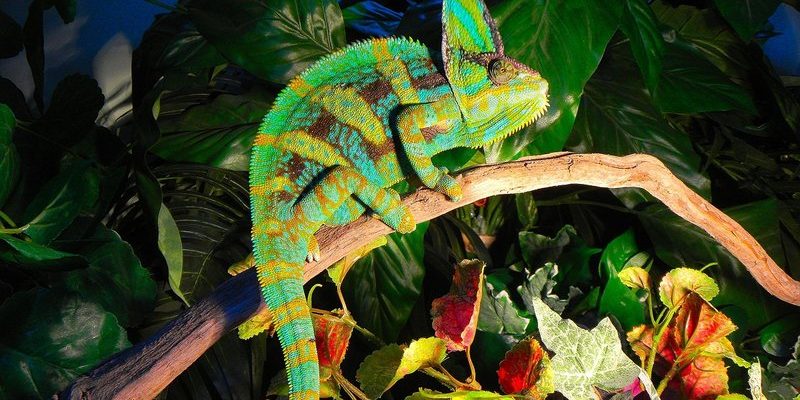
The veiled chameleon, also known as *Chamaeleo calyptratus*, is native to the Arabian Peninsula, particularly in regions of Yemen and Saudi Arabia. Here, these amazing reptiles navigate through trees and shrubs, showcasing their vibrant colors and unique behaviors. But their story goes beyond their striking outward appearances. Understanding their role in their habitat reveals the intricate balance of nature and the importance of every species, no matter how small.
Habitat and Distribution of the Veiled Chameleon
The veiled chameleon is typically found in dry, desert-like areas with plenty of vegetation. You might picture a sun-drenched landscape dotted with shrubs and trees. This is where they thrive! These lizards prefer warm, arid climates with temperatures that can often exceed 95°F (35°C) during the day. However, they need access to cooler spots during the hotter parts of the day to avoid overheating.
In their natural habitat, veiled chameleons are often found in trees and bushes. They love climbing, using their zygodactylous feet—think of them as having two “fingers” on each side—to grasp branches securely. Their habitat is a mix of elevation and dense foliage, which provides them with not just shelter but also a great hunting ground. This is vital since their diet primarily consists of insects, such as crickets and locusts, which they catch using their unique, sticky tongues.
Role in the Ecosystem
You might be surprised to learn that veiled chameleons play a crucial role in their ecosystem as both predators and prey. By feeding on insects, they help control pest populations. Imagine their long, sticky tongues darting out to snag a meal! This feeding behavior keeps the insect populations in check and contributes to a balanced ecosystem.
However, these chameleons are also a part of the food chain. Larger birds, snakes, and even some mammals see them as tasty snacks. This predator-prey dynamic is essential for maintaining biodiversity. By being part of this intricate web of life, veiled chameleons help ensure that no species overpopulates and disrupts the natural balance.
Color Change: A Key Survival Mechanism
One of the most captivating features of the veiled chameleon is its ability to change color. You might think this is just for show, but it’s actually more than that—it’s a key survival mechanism. Chameleons change color for various reasons: to regulate their body temperature, communicate with other chameleons, or blend into their surroundings to avoid predators.
When a veiled chameleon feels threatened, it might turn darker to absorb more heat or lighter to reflect sunlight. Their color change can also signal moods; for example, a chameleon might display brighter colors when it’s excited or during mating season. It’s a fascinating phenomenon that goes beyond mere aesthetic appeal; it’s about survival and social interaction.
Breeding and Life Cycle
Breeding is another important aspect of the veiled chameleon’s life. Mating usually occurs between spring and summer. Male chameleons often compete for females, displaying bright colors and puffing up to appear larger. It’s a bit like a beauty pageant but with more hissing!
After a successful mating season, females lay eggs. Depending on conditions, they can lay anywhere from 20 to 50 eggs in a single clutch. These eggs are buried in the ground, where they’ll incubate for about 4 to 6 months. Once the baby chameleons hatch, they emerge fully formed and ready to fend for themselves. This gives them an advantage as they can start their lives off in a somewhat independent manner, but it also means they face the challenges of survival early on.
Environmental Threats and Conservation Efforts
Despite their adaptability, veiled chameleons face several threats from their environment. Habitat destruction due to urban development and agriculture is a significant concern. As their natural habitats shrink, these creatures struggle to find the resources they need to thrive.
Conservation efforts are crucial to protect the veiled chameleon and its habitat. Many organizations work tirelessly to promote awareness and support conservation programs. Efforts like habitat restoration and community education can help safeguard this unique species. After all, a healthy ecosystem benefits not just one species but all living things within it.
Why the Veiled Chameleon Matters
So, why should we care about the veiled chameleon? Well, each organism plays a role in maintaining the delicate balance of its ecosystem. The veiled chameleon serves as a reminder of the beauty and complexity of nature, illustrating how one species can impact many others.
Moreover, studying these reptiles can provide insights into broader ecological processes, making them valuable to researchers and conservationists alike. Protecting them not only helps preserve their species but also ensures the overall health of their ecosystems.
The journey of the veiled chameleon through its natural habitat is a captivating tale of survival, adaptation, and interdependence. From their colorful displays and unique hunting techniques to their vital roles in controlling insect populations, these creatures highlight the incredible complexities of nature. By appreciating the role of the veiled chameleon, we can come to understand the broader importance of biodiversity and conservation efforts.
In the end, it’s about ensuring that future generations can marvel at these amazing reptiles and the intricate ecosystems they inhabit. So, the next time you think of a veiled chameleon, remember: it’s more than just a color-changing lizard—it’s a vital piece of the natural puzzle.

